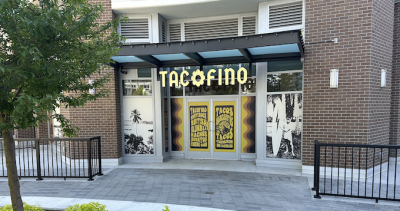Richmond Olympic Oval's art showcases flow, flight, and fusion
It’s been more than a year since the Richmond Olympic Oval opened to the public. But on this late fall day, building activity continues to swirl around its exterior. Responsibility for the facility has shifted temporarily from the City of Richmond, which operates the oval as a multi-use sports and recreation centre, to Vanoc, which is readying it for the 2010 Olympic speed skating competitions.
Trucks and earthmovers roar around in the mud. Near the newly planted trees and shrubs on the grounds north of the oval, workers labour on Sight Works, a project that weds site furnishings to public art. Designed by Vancouver sculptor Elspeth Pratt and her partner, architect Javier Campos, it comprises a long, low “seatwall” of striated concrete, punctuated by angular steel and wood decks, all set on the dyke behind the oval.
Eric Fiss, public-art planner for the City of Richmond, tours the Straight around the building and its outdoor art. Braving the bitter wind, he talks about the ways all the artists here have worked closely with architects and landscape designers and have thought carefully about the area’s cultural history and natural environment. “It’s an integrated concept,” Fiss says. “All the art works with the themes for the building, which are flow, flight, and fusion.”
“Flow” alludes to movement, to both the speed skaters within the oval and the middle arm of the Fraser River on which the building is sited. “Flight” is again natural and cultural, from local birds such as herons to planes arriving at and departing from the nearby Vancouver International Airport. “And fusion is a blending of ideas, cultures, components—integrating design and art in an innovative way,” Fiss explains.
There is also, he adds, “a big sustainability theme”, of which the art is again a part. For instance, acclaimed Musqueam artist Susan Point designed the cast concrete runnels set into the 15 huge buttresses on the north side of the oval exterior. With their stylized images of salmon, herons, and strands of water, these works pick up the theme of flow. They recognize the cycle of life in and around the Fraser River, and the generations of Musqueam people who have lived on its banks.
The runnels also function as part of a system that collects rainwater from the roof of the oval and directs it into a large pond on the east and north sides of the building, Fiss explains. In the pond, biofiltration processes and aeration devices make the water reusable, either for gradual, flood-control release into the river, or as “grey water” for toilets, urinals, and landscape watering at the oval.
Ice Blade by Seattle artist Buster Simpson is also both functional and beautiful. A series of sculptural pylons composed of metal and prismatic glass, it mimics and greatly enlarges the forms and angles of speed-skating blades positioned at the starting line. Located on a new bridge over an old drainage canal, the sculptures serve as energy-efficient LED lamps at night and as a gateway to the oval, marking the threshold between Richmond’s past and present.
Hanging high above the pond are ephemeral lanterns, two immense net sculptures by American artist Janet Echelman. They take up the theme of fusion, their lantern shapes alluding to the Asian peoples who have settled in Richmond and their netting material suggestive of the multicultural local fishing industry.
Recently installed on the north side of the oval, overlooking the river, is Hupakwanum. Created by Nuu-chah-nulth artists Tim Paul and Rod Sayers and their apprentices, it consists of a wood and glass tower and obelisk. In its depiction of a stack of bentwood boxes, the glass etched with images of creatures of the sea, land, and sky, the tower fuses contemporary and traditional means and forms.
Nearby, Pratt and Campos’s Sight Works will function as walkway, benches, viewing platforms, and environmental markers when completed. “The artists did an integrated project with the landscape team,” Fiss says, alluding to the fact that the dyke and its environs are protected here. “What the landscape team is doing is reinforcing or restoring some of the environmental quality of the dyke—the riverbank, the grass, and the plantings.”
Sight Works speaks eloquently to its location. The concrete wall is executed in layered earth tones, the striations evoking Richmond’s alluvial setting, with its successive deposits of mud, silt, and sand. “It interprets the environmental and cultural aspects of the site,” says Fiss, “in an intuitive and experiential way.”















Comments
2 Comments
Chris Wu
Feb 19, 2010 at 10:37am
This is not cool.
Minxing Wang
Feb 19, 2010 at 10:44am
i'm gay